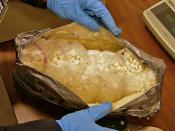Ecstasy: The True Side of a False Drug.
"A survey of 16-29 year olds in the United Kingdom showed that 9% of surveyors had used ecstasy. After surveying members of the rave scene, the numbers rose to 91%" (Weir 5). A statistic like that gives plenty of reason for the need of both awareness and a form of enforcement against the use of the drug ecstasy. Although this drug is relatively new, the use of ecstasy is rising. Unfortunately, the drug has serious effects: change of mood, sex drive, appetite, and sleep. Such effects often blanket the drugs true dangers. " In January 2000, [â¦], inquest into the death of a 21-year-old Ontario resident who had collapsed at a rave. Several other rave-related deaths in Ontario, Nova Scotia, in the fall of 1999 raised the possibility of raves as a public heath hazard" (Weir 1). Ecstasy is more often hazardous than fun, and it is taking away too many lives of teenagers and young adults.
Because we are losing many teens as a result of using of ecstasy, getting information about risks of the drug, while also laying down some form of enforcement is mandatory. While reducing the chance of risks and enforcing laws, it would begin to help decrease the rising amount of injuries and deaths young adults are suffering.
What exactly is ecstasy and where did it come from? If you asked an ecstasy user that same question they almost certainly couldn't answer it accurately. Ecstasy is medically known as MDMA, (methylenedioxymethamphetamine). MDMA shares properties with both amphetamine and hallucinogenic drugs. A release of the neurotransmitter serotonin also takes place with ingestion of the drug, and serotonin is thought to be associated with the high of being in love. The MDMA sparked surge of the feel good...


